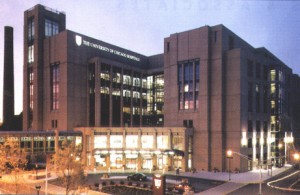
Chicago Hospitals
Some of the Chicago area’s best-known teaching hospitals turn out the fewest primary-care doctors in the nation, despite a growing shortage of general practitioners that leaves many people without basic treatment.
Northwestern Memorial Hospital and University of Chicago Medical Center are in the bottom 15% of 158 large teaching hospitals across the country in the proportion of primary-care doctors produced in 2006-08, according to a study of graduate medical education released last month. Rush University Medical Center is in the bottom third, ranked by the percentage of residents and fellows graduated in fields such as internal medicine, family medicine and pediatrics.
Contributing to the shortage is Medicare, which gives teaching hospitals special funding regardless of the mix of doctors they train. Subsidies in 2011 included $34.2 million for Northwestern Memorial, $44.1 million for U of C and $46.3 million for Rush, the highest in the state.
Chicago-area teaching hospitals say they produce so many specialists because they are among the most prestigious medical centers in the nation, a source of scientific breakthroughs that help patients everywhere.
But critics, including some leaders of local med schools, say the mismatch between the supply and demand for primary-care doctors reflects healthcare’s obsession with costly, high-tech treatments of serious illnesses rather than less-glamorous preventive care. With the number of Medicare-funded residency slots capped, the financial rewards spur teaching hospitals to focus on lucrative inpatient specialties, they say.
“Are they producing the doctors that America really needs?” asks Dr. Candice Chen, the researcher at George Washington University in Washington who led the study, published in Academic Medicine. “Or are they producing the doctors that are driving up the cost of healthcare?”
LITTLE INCENTIVE
Medicare’s formula for funding graduate medical education is receiving new scrutiny as the federal government barrels toward another round of budget negotiations as the debt ceiling approaches, possibly as soon as September. President Barack Obama has already called for reducing the $10 billion annual subsidy to teaching hospitals by an average of $1.1 billion over the next decade, according to his fiscal 2014 budget (PDF).
While no hospital executive favors a drop in federal funding, some say the formula should be revised.
“If you want to get desired behavior, you figure out a way to incentivize or encourage it,” says Dr. Susan Vanderberg-Dent, a family medicine practitioner and an associate dean at Rush. “That hasn’t been there.”
Eleven precent of Rush’s 598 residents completed their training in primary care, the study finds.
Many fledgling doctors don’t find primary care attractive because of the pay. Family practice doctor salaries average $189,000 a year, while many specialists, ranging from cardiologists to ear-nose-and-throat doctors, make twice that, according to a survey by physician search firm Merritt Hawkins & Associates.
A reduction in funding for graduate medical education would come on top of decreases in reimbursements under Mr. Obama’s Affordable Care Act, hospital executives say.
“Further cuts that would impact GME would go at the heart of our ability to respond to the demand for services,” says Benjamin Gibson, vice president of governmental affairs at U of C Medicine, which includes the medical center and the med school.
The study counted residents and fellows at hospitals with at least 150 graduates in 2006-08. Residents are med school graduates working under a licensed physician, while fellows have completed their residencies and are taking advance training.
Source: modernhealthcare.com








